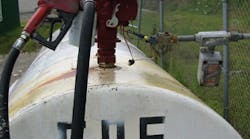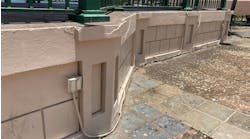How well do you know the Code? Think you can spot violations the original installer either ignored or couldn't identify? Here's your chance to moonlight as an electrical inspector and second-guess someone else's work from the safety of your living room or office. Joe Tedesco, who has a knack for finding shoddy electrical work, did the dirty work and found this mess. Now it's your turn to identify the violation.
Find the Answer
Answer:
This gasoline dispenser is located adjacent to an active job site. To top it off, the tank sits directly behind a city hall in West Virginia — where it's used to fuel city-owned vehicles, including the one driven by the AHJ and his assistant.
Congratulations to the following three readers, who correctly identified the problems associated with this installation: Dan Naugle, P.E., engineering manager, Boeing Corp., Moore, Okla.; Nick Volpenhein, E.I.T., project manager, Volpenhein Brothers Electric, Cincinnati; and Kyle Aylor, project manager, Valentine Electrical, Ashland, Va.
It appears this installation might have been compliant at some point (i.e., rigid conduit, seal-off, explosionproof devices, etc.), but what's here now certainly doesn't comply with the requirements of Art. 501 for a Class I, Division 1 location.
The box is not properly supported, and there should be a seal-off between the tee and switch box. There doesn't appear to be an equipment-grounding conductor running to the pump motor, and getting to the switch to turn on the pump or perform maintenance may yield accessibility issues. Let's not forget about those open-air connections in a hazardous (classified) location!
The missing seal doesn't prevent moisture from entering or accumulating within the box, conduit body, or fitting. This is a violation of 314.15(A). You can also cite this installation as not meeting the requirements of 501.15(E)(1).
The requirements of Art. 514 for motor fuel dispensing facilities also apply to this installation. However, the current equipment configuration would never comply with Table 514.3(B)(1).



